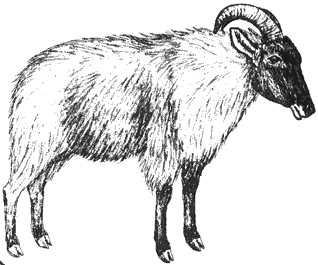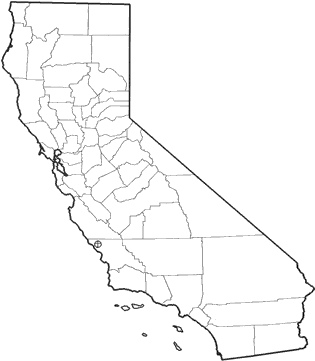
Tahr
Distribution, Abundance, and Seasonality
The tahr is an uncommon, yearlong resident of valley foothill hardwood and open grassland habitats on the Hearst Ranch, San Luis Obispo Co. (Barrett 1966). Probably no more than a few hundred of these introduced, goat-like animals live on the ranch. Native to Himalayan region, from Kashmir to Sikkim.

Range Map
Specific Habitat Requirements
Feeding: Barrett (1966) suggested that tahr on the Hearst Ranch fed primarily on grasses, forbs, and to a lesser extent on browse, such as live oak, toyon, poison-oak, and laurel. Detailed food habits studies are lacking.
Cover: Rock outcrops and cliffs appear to be almost essential for escape cover and for bedding. The tahr, which evolved in a cooler climate, may require shaded woodlands and north-facing slopes in summer.
Reproduction: Rock outcrops and rugged cliffs offer protection from predators during breeding.
Water: No data found.
Pattern: Tahr use a mixture of valley foothill hardwoods and open grasslands, interspersed with rocky outcrops for protection. In native Himalaya habitat, rocky, wooded mountain slopes and rugged hills are preferred (Nowak and Paradiso 1983).
Species Life History
Activity Patterns: Active yearlong; primarily diurnal.
Seasonal Movements / Migration: Non-migratory in areas of moderate topographic relief, such as the Hearst Ranch.
Home Range: Bachelor herds of different sizes and age-classes are found, as well as composite bands of mature females, immature bulls, and kids (Anderson and Henderson 1961). Native herds contain 2-23 individuals. In New Zealand, densities of 4.5 to 6.8/km? (0.4 mi?) were reported among the introduced populations (Nowak and Paradiso 1983).
Territory: No data found.
Reproduction: The rut in the Himalayas occurs from October through January. In New Zealand, it begins in late April and lasts until early June (Anderson and Henderson 1961). Probably rut in the autumn in California. During the rut, bulls pair with estrous females. Parturition is in December in New Zealand; probaby in May or June in California. Females become sexually mature at about 2 yr and breed each yr thereafter.
Niche: This introduced bovid may compete with other exotic ungulates on the Hearst Ranch, as well as with livestock and native black-tailed deer. Potential predators include mountain lions, which could prey on adults and young, and bobcats and coyotes, which probably would prey mostly on young.
Sources & References
California Department of Fish and Game, 1999.
California's Wildlife, Sacramento, CA.
Written by: R. A. Hopkins, reviewed by: H. Shellhammer, edited by: J. Harris, S. Granholm
Anderson, J. A., and J. B. Henderson. 1961. Himalayan tahr in New Zealand. Symposium on animal-forest relationships. Tenth Pac. Sci. Congr., Honolulu, Hawaii. New Zealand Deerstalkers Assoc. Special Publ. No. 2. 37pp. Barrett, R. H. 1966. History and status of introduced ungulates on Rancho Piedra Blanca, California. M.S. Thesis, Univ. Michigan, Ann Arbor. 141pp. Nowak, R. M., and J. L. Paradiso. 1983. Walker's mammals of the world. 4th ed. 2 vols. John Hopkins Univ. Press, Baltimore, MD. 1362pp.
California Animal Facts | California's Wildlife